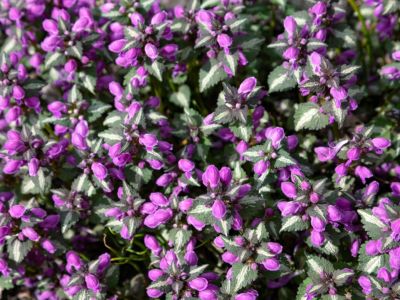Plant Alternatives to Grass
Groundcovers
With groundcover plants, you can easily knock out the dreaded chore of mowing the grass. These low-growing plants spread easily in even the toughest sites, providing thick coverage that will eventually benefit the soil beneath. Groundcovers can also add appealing texture, with some varieties having seasonal blooms and colorful fall foliage. You can even choose nitrogen-fixing plants, like clover, which act as a soil conditioner. Ajuga is a creeping evergreen that works well in both sun and shade. Varieties with purple foliage are also available. If you have a shady site that doesn’t take grass well, put in some ivy. Soon you will have a lush carpet of green. Creeping Jenny is sometimes considered an invasive weed in the yard; however, this plant will make a great groundcover to replace a lawn. With its yellow blooms and coin-looking foliage, creeping Jenny will easily brighten up the lawn, especially shady areas. Dead nettle is another option. Don’t let the name put you off, this is actually an attractive groundcover with lovely, variegated foliage and stunning spring blooms.
Fescue and Ornamental Grass
Both fescue and ornamental grasses provide another alternative to the traditional lawn. Fescue grasses are tolerant of everyday wear and tear and can thrive in a variety of locations. Tall fescues are coarser, drought tolerant, and provide a very low maintenance lawn for your home. Ornamental grasses are also low-maintenance plants that make great lawn alternatives. Since there are numerous types to choose from, finding one that meets your specific needs shouldn’t be a problem. However, sticking to a variety that is native to your area will increase your chances of success. A native grass lawn requires little supplemental water once it’s established and doesn’t suffer from many pest or disease problems. Native grasses can be mown or left alone to create the appearance of a natural prairie.
Flowers, Herbs and Vegetables
Another option for your lawn includes the incorporation of flowers, consisting of carefully placed beds or stunning meadows. Flowerbeds are easy to create and significantly lessen your mowing needs by reducing the amount of lawn you have. Wildflowers mixed in with prairie grasses will create a lovely meadow; however, check first to see what varieties thrive in your area. A meadow can add striking color and texture to your landscape while providing a low maintenance solution to the traditional grass-covered lawn. If a meadow is not for you, perhaps you would like to implement a vegetable garden instead. Whether it comes in the form of a huge plot or several small beds, a vegetable garden not only replaces areas of lawn but also produces mouth-watering food. You can even mix in some flowers and herbs. Want to add a delightful fragrance? Try herbs as a lawn alternative. There are many easy-care varieties available that hold up well to foot traffic. In fact, walking through these aromatic plants will actually trigger their pleasant scents. Popular choices include creeping thyme, chamomile, and pennyroyal. Another interesting way to cover the lawn and add color is with bulbs. This works great for problem areas which are difficult to mow. Simply take handfuls of selected bulbs and gently toss them into the site. Plant the bulbs where they landed for a naturalized appearance.
